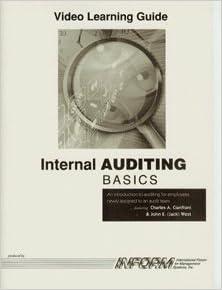Question
Case lets Axis Hedges the Euro In 1999 when the European Union introduced the euro, Michael Jones, owner, and CEO of Axis Ltd., a small
Case lets
Axis Hedges the Euro
In 1999 when the European Union introduced the euro, Michael Jones, owner, and CEO of Axis Ltd., a small manufacturer of wiring components for the aerospace industry, though it would be a good idea to start pricing sales to European customers in euros (m). In late 1998, Axis entered into multi-year deals with two European aerospace companies to supply wiring. The prices were calculated using an exchange rate of $1_m1.18, which was just a little stronger than the exchange rate for the euro at the time of its introduction in January 1999.
As Jones later noted: Stupid us! At the time the euro was introduced, no one thought its value would immediately plunge against the dollar. We thought the currency would trade in a narrow range against the dollar, and that pricing in euros was in the best interests of our European customers. However, the euro promptly fell against the dollar, bottoming out at nearly $1_m0.82 in October 2000.
For Axis, the plunge was devastating. One of the contracts called for Axis to supply m5 million of wiring to a European customer in 2000. Axis had hoped to generate $5.9 million in revenue at an exchange rate of $1_m1.18 (m5 million _ 1.18 _ $5.9 million). The company knew that as long as the euro stayed over $1_m1.05 it would be able to make a decent profit on the deal. However, when payment was due, the exchange rate stood at $1_m0.88, and the m5 million deal netted Axis only $4.4 million in revenues. Axis lost money that year due to the adverse movement in foreign exchange rates. The companys 10 top managers all took 20 percent pay cuts, there were no profit-sharing bonuses, and no other employees got a raise. To make sure that didnt happen again, Jones began to actively hedge against adverse currency movements in 2000. To do this, Axis entered the foreign exchange market, buying currency forward (that is, entering a contract today to buy currency at some point in the future at a predetermined exchange rate).
For example, in late 2000, Axis entered a contract to supply wire to a European customer in the first half of 2001, with payment due in June 2001. The total value of the contract was m2.5 million. At the time, the prevailing dollar/euro exchange rate was $1_m0.90, so the contract would generate $2.25 million in revenues for Axis (m2.5 million _ 0.9_ $2.25 million). To protect this projected revenue stream from adverse movement in the exchange rate, Axis entered into a forward contract with the foreign exchange desk of its bank to change euros into dollars on July 1, 2001. The bank quoted Axis a rate of $1_m0.94 for making the exchange on that date, which would guarantee Axis $2.35 million. The higher forward rate offered by the bank reflected the view of the foreign exchange market that the euro would appreciate a little against the dollar over the next year. To Jones, this seemed like a good deal and he entered the contract. But on July 1, the exchange rate stood at $1_m0.85. The foreign exchange market was wrong, and the euro had depreciated against the dollar. Had Axis not entered into the forward exchange contract, its m2.5 million in revenues would have been worth only $2.125 million, not the $2.35 million Axis actually received by executing the forward contract. It doesnt always work in our favor though, notes Jones. In 2002, we entered another forward contract to supply wiring through till early 2003. We hedged the exchange rate risk by buying dollars forward on the market at $1_m0.95, which was the forward rate at the time. But guess what! In March 2003, when the customer had to pay, the exchange rate stood at $1_m1.07. Had we not hedged, we would have made a tidy sum on the appreciation in the value of the euro against the dollar, but I cannot stomach the risk associated with that type of speculation anymore. I would rather know what I am getting.
Step by Step Solution
There are 3 Steps involved in it
Step: 1

Get Instant Access to Expert-Tailored Solutions
See step-by-step solutions with expert insights and AI powered tools for academic success
Step: 2

Step: 3

Ace Your Homework with AI
Get the answers you need in no time with our AI-driven, step-by-step assistance
Get Started


